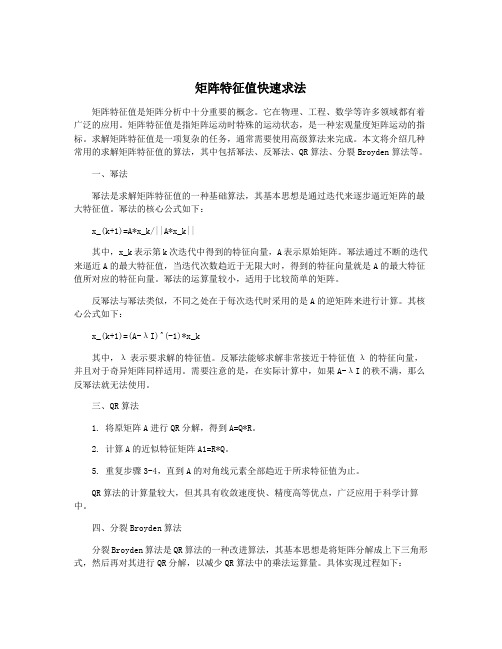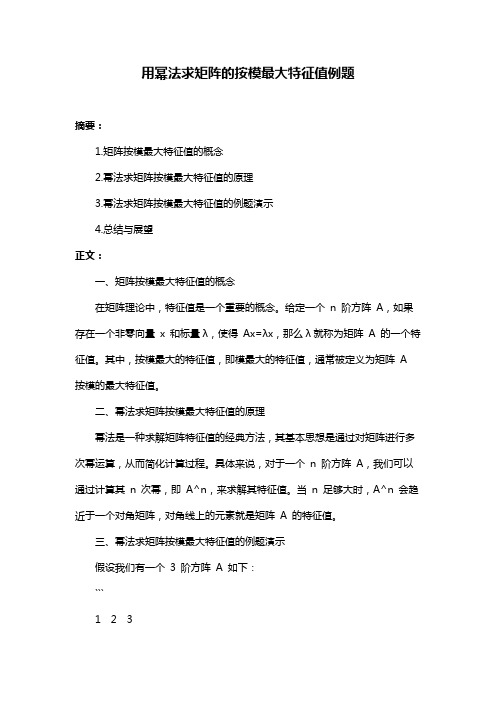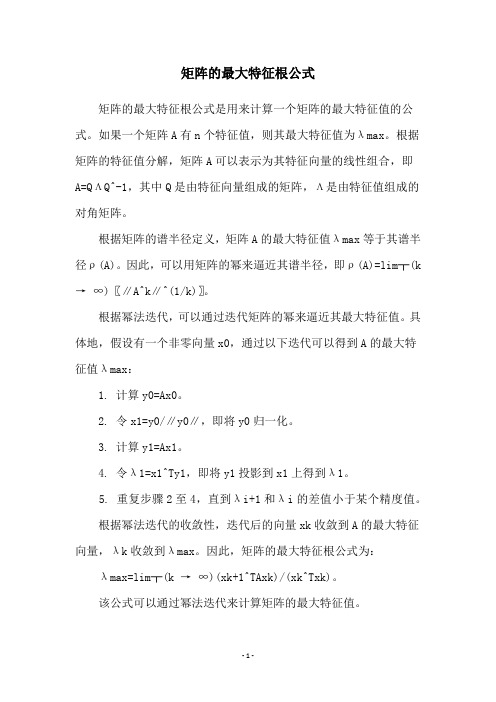幂法求矩阵最大特征值
矩阵特征值及其计算方法的应用

矩阵特征值及其计算方法的应用矩阵特征值是线性代数中的重要概念,它在各个学科领域都有着广泛的应用,如物理学、工程学、计算机科学等。
本篇文章将针对矩阵特征值及其计算方法的应用进行探讨,以期帮助读者更好地理解和应用这一概念。
一、矩阵特征值的定义矩阵特征值是指一个矩阵在行列式中的解,也称为特征根。
对于给定的矩阵A,如果存在一个实数λ和非零向量v,使得:Av=λv,则称λ为矩阵A的特征值,v为相应的特征向量。
二、矩阵特征值的计算方法计算矩阵特征值的方法有很多种,其中比较常用的有特征值分解法、幂法、反迭代法等。
下面我们就来简单介绍一下这几种方法:1、特征值分解法:通过求解矩阵的特征值和特征向量,可以将任何一个n阶方阵A表示为:A=QΛQ^(-1),其中Λ是一个对角线矩阵,其对角线上的元素为矩阵A的特征值,Q是由矩阵A的n个特征向量组成的矩阵,并满足Q^(-1)Q=I。
2、幂法:幂法是求解矩阵最大特征值的一种方法。
具体步骤为:首先选择一个非零向量v0作为初始向量,然后进行迭代计算,直至收敛为止。
每次迭代时,都将向量v0乘以矩阵A,并将结果归一化得到下一个向量v1,即:v1=A·v0/||A·v0||。
重复这个步骤直到v1和v0之间的距离小于一定的阈值。
3、反迭代法:反迭代法是幂法的一种改进方法,用于求解矩阵的近似特征值及其对应的特征向量。
该方法的思想是对原问题进行转化,将求解矩阵最大特征值的问题转化为求解矩阵最小特征值的问题。
具体实现时,需要对矩阵A进行平移,使得新矩阵B=μI-A的特征值与B的特征值相互对应,在这个基础上再进行幂法的计算即可。
三、矩阵特征值的应用矩阵特征值由于具有很好的数学性质和广泛的应用场景,因此在各个领域都有着深入的研究和广泛的应用。
下面我们就针对几个具体场景来介绍一下矩阵特征值的应用。
1、图像处理:矩阵特征值在图像处理中有着重要的应用,通过分解一张图像对应的矩阵的特征值和特征向量,可以将原图像进行降维处理,从而达到图像压缩和图像增强的目的。
矩阵最大特征值求法

矩阵最大特征值求法矩阵最大特征值求法矩阵最大特征值是矩阵理论中的重要概念,它在很多领域都有广泛的应用,如物理、化学、工程等。
在实际应用中,我们需要求解矩阵的最大特征值和对应的特征向量,以便对矩阵进行分析和处理。
本文将介绍两种常用的矩阵最大特征值求法:幂法和反迭代法。
一、幂法幂法是求解矩阵最大特征值和对应特征向量的一种常用方法。
其基本思想是:对于一个矩阵A,我们可以随机选择一个向量x0,然后通过不断迭代,使得向量x0趋近于矩阵A的最大特征值所对应的特征向量。
具体步骤如下:1. 随机选择一个向量x0,使其满足||x0||=1。
2. 对向量x0进行迭代,得到向量x1,即x1=Ax0。
3. 对向量x1进行归一化,得到向量x2,即x2=x1/||x1||。
4. 重复步骤2和步骤3,直到向量x收敛于矩阵A的最大特征值所对应的特征向量。
在实际应用中,为了提高计算效率,我们可以对向量x进行正交化处理,即每次迭代后,将向量x与前面所有的向量进行正交化,以避免向量的线性相关性对计算结果的影响。
二、反迭代法反迭代法是一种基于幂法的改进算法,它可以求解矩阵的任意一个特征值和对应的特征向量。
其基本思想是:对于一个矩阵A和一个已知的特征值λ,我们可以通过反迭代法,求解出矩阵A中与特征值λ最接近的特征值和对应的特征向量。
具体步骤如下:1. 随机选择一个向量x0,使其满足||x0||=1。
2. 对向量x0进行迭代,得到向量x1,即x1=(A-λI)-1x0,其中I为单位矩阵。
3. 对向量x1进行归一化,得到向量x2,即x2=x1/||x1||。
4. 重复步骤2和步骤3,直到向量x收敛于矩阵A中与特征值λ最接近的特征向量。
在实际应用中,我们可以通过多次迭代,求解出矩阵A中多个特征值和对应的特征向量,以便对矩阵进行更全面的分析和处理。
总结矩阵最大特征值求法是矩阵理论中的重要内容,幂法和反迭代法是常用的求解方法。
在实际应用中,我们需要根据具体情况选择合适的方法,并注意算法的收敛性和计算效率。
幂法(指数迭代法)

幂法(指数迭代法) 幂法是通过迭代来计算矩阵的主特征值(按模最⼤的特征值)与其对应特征向量的⽅法,适合于⽤于⼤型稀疏矩阵。
基本定义 设A=(a ij)∈R n×n,其特征值为λi,对应特征向量x i(i=1,...,n),即Ax i=λi x i(i=1,...,n),且{x1,...,x n}线性⽆关。
任取⼀个⾮零向量v0∈R n,且v0≠0,构造⼀个关于矩阵A的乘幂的向量序列:v k=Av k−1=A2v k−2=A3v k−3=...=A k v0 称v k为迭代向量。
设特征值λi的前r个为绝对值最⼤的特征值(ppt中分为λ1强占优和⾮强占优,感觉没必要),即有:|λ1|=|λ2|=...=|λr|>|λr+1|≥...≥|λn| 由于{x1,...,x n} 线性⽆关,所以构成R n的⼀个基,于是v0能被表达为:v0=n∑i=1αi x i(且设α1...αr⾮全零) 由Ax i=λi x i:v k=Av k−1=...=A k v0=n∑i=1A kαi x i=n∑i=1λk iαi x i=λk1(r∑i=1αi x i+εk) 其中:εk=n∑i=r+1(λiλ1)kαix i 因为λ1最⼤,所以有|λiλ1|<1 (i=r+1,...,n),从⽽有:limk→∞(λiλ1)k=0 (i=r+1,...,n) 所以有:limk→∞εk=0limk→∞v k=limk→∞λk1(r∑i=1αi x i+εk)=limk→∞λk1(r∑i=1αi x i) 因为在上式中(r∑i=1αi x i)是固定项,可以看出,迭代到后期,v k+1和v k的各个元素有固定⽐值λ1,即:limk→∞(v k+1)i(v k)i=λ1 这样,收敛到主特征值后,还可另外计算它对应的⼀个特征向量(其实就是构成v0的前r项之和,⽽且只能算⼀个):lim k→∞v kλk1=r∑i=1αi x i 其中收敛速度由⽐值|λr+1λ1|决定,越⼩收敛越快。
幂法反幂法求解矩阵最大最小特征值及其对应的特征向量

幂法反幂法求解矩阵最大最小特征值及其对应的特征向量幂法和反幂法是求解矩阵最大最小特征值及其对应特征向量的常用方法。
在本文中,我们将详细介绍这两种方法的原理和具体实现。
一、幂法(Power Method)幂法是一种迭代算法,用于求解矩阵的最大特征值及其对应的特征向量。
其基本思想是通过多次迭代得到矩阵的一个特征值和特征向量的近似值,并使其逼近真实值。
幂法的原理如下:1.初始化一个非零向量b0作为初始特征向量;2.计算b0的归一化向量b0/,b0,得到新的向量b1;3.计算矩阵A和向量b1的乘积Ab1,得到新的向量b2;4.对b2进行归一化,得到新的向量b3;5.重复步骤3和步骤4,直到b的变化趋于稳定;6.计算矩阵A和向量b的乘积Ab,得到新的向量b;7.特征值的近似值λ=,Ab,/,b。
具体实现如下:1.初始化一个非零向量b0;2.迭代n次进行如下操作:a. 计算bn=A*bn-1;b. 将bn进行归一化,得到bn=bn/,bn;3. 计算特征值的近似值lambda=,A*bn,/,bn;4. 特征向量的近似值vbn=bn。
幂法的优点是计算简单、迭代次数少,但对于含有多个特征值接近的矩阵,可能会收敛到次大特征值。
二、反幂法(Inverse Power Method)反幂法是幂法的拓展,用于求解矩阵的最小特征值及其对应的特征向量。
其基本思想是通过多次迭代得到矩阵的一个特征值和特征向量的近似值,并使其逼近真实值。
反幂法的原理如下:1.初始化一个非零向量b0作为初始特征向量;2.计算b0的归一化向量b0/,b0,得到新的向量b1;3.计算矩阵A的逆矩阵Ai和向量b1的乘积Ai*b1,得到新的向量b2;4.对b2进行归一化,得到新的向量b3;5.重复步骤3和步骤4,直到b的变化趋于稳定;6.计算矩阵A的逆矩阵Ai和向量b的乘积Ai*b,得到新的向量b;7.特征值的近似值λ=,Ai*b,/,b。
具体实现如下:1.初始化一个非零向量b0;2.迭代n次进行如下操作:a. 计算bn=inv(A)*bn-1;b. 将bn进行归一化,得到bn=bn/,bn;3. 计算特征值的近似值lambda=,inv(A)*bn,/,bn;4. 特征向量的近似值vbn=bn。
最大特征值计算公式

最大特征值计算公式
最大特征值是矩阵特征值中最大的一个,它在数学、物理、工程、经济学等多个领域中都有广泛应用。
最大特征值的计算方法有多种,其中一种常见的是幂法求解法。
幂法求解法是一种基于迭代的方法,它通过不断对矩阵进行重复乘法来逼近最大特征值。
具体而言,该方法首先需要选择一个随机向量x作为初始向量,然后对矩阵A进行多次乘法,
得到一系列向量{x, Ax, A^2x, A^3x, ...},其中向量的长度可能
会发生变化。
在每次计算中,都需要将当前向量除以其范数,使其成为单位向量,然后用新向量与旧向量进行比较以判断算法是否已经收敛。
当新向量与旧向量的差值小于一个给定的容差时,算法即停止,此时新向量的方向即为最大特征值所对应的特征向量。
具体来说,幂法计算最大特征值的公式为:
λ = lim(k→∞) (Akx_k · x_k)/(x_k · x_k)
其中,λ为最大特征值,x_k为第k次迭代得到的向量,A为
待求解矩阵,k为迭代次数。
由于幂法计算的复杂度较低且具有较好的数值稳定性,在实际应用中得到了广泛的应用。
同时,该方法也存在一些限制,如会受到矩阵特征值分布的影响,可能会在某些情况下收敛缓慢,因此需要在实际应用中结合具体问题进行调优。
矩阵特征值快速求法

矩阵特征值快速求法矩阵特征值是矩阵分析中十分重要的概念。
它在物理、工程、数学等许多领域都有着广泛的应用。
矩阵特征值是指矩阵运动时特殊的运动状态,是一种宏观量度矩阵运动的指标。
求解矩阵特征值是一项复杂的任务,通常需要使用高级算法来完成。
本文将介绍几种常用的求解矩阵特征值的算法,其中包括幂法、反幂法、QR算法、分裂Broyden算法等。
一、幂法幂法是求解矩阵特征值的一种基础算法,其基本思想是通过迭代来逐步逼近矩阵的最大特征值。
幂法的核心公式如下:x_(k+1)=A*x_k/||A*x_k||其中,x_k表示第k次迭代中得到的特征向量,A表示原始矩阵。
幂法通过不断的迭代来逼近A的最大特征值,当迭代次数趋近于无限大时,得到的特征向量就是A的最大特征值所对应的特征向量。
幂法的运算量较小,适用于比较简单的矩阵。
反幂法与幂法类似,不同之处在于每次迭代时采用的是A的逆矩阵来进行计算。
其核心公式如下:x_(k+1)=(A-λI)^(-1)*x_k其中,λ表示要求解的特征值。
反幂法能够求解非常接近于特征值λ的特征向量,并且对于奇异矩阵同样适用。
需要注意的是,在实际计算中,如果A-λI的秩不满,那么反幂法就无法使用。
三、QR算法1. 将原矩阵A进行QR分解,得到A=Q*R。
2. 计算A的近似特征矩阵A1=R*Q。
5. 重复步骤3-4,直到A的对角线元素全部趋近于所求特征值为止。
QR算法的计算量较大,但其具有收敛速度快、精度高等优点,广泛应用于科学计算中。
四、分裂Broyden算法分裂Broyden算法是QR算法的一种改进算法,其基本思想是将矩阵分解成上下三角形式,然后再对其进行QR分解,以减少QR算法中的乘法运算量。
具体实现过程如下:2. 构造一个倒数矩阵B=U^(-1)*L^(-1)。
4. 计算A的近似特征矩阵A1=Q^(-1)*L^(-1)*A*R^(-1)*U^(-1)*Q。
分裂Broyden算法的计算量较小,能够有效地解决QR算法中的乘法运算量过大的问题。
求矩阵的最大特征值的幂法

除非这个函数有特殊的作用,如申请内存,或要读入外部文本内容到二维指针等。其余的情况,一律不对外部指针进行任何申请或释放内存的处理。
对于要保护数据的外部传入指针,则在函数内部再做一个局部指针,在函数结尾释放.
对局部指针的操作,也仅限于赋值,而绝对不要用外部传入针指去指向它(即赋一个临时区的地址给外部的指针变量),这当然是错误的。
do
{
assertF(listNotZero(listU,size),"in the core of powerMethodForLamda list U is NULL\n");
assertF(listNotZero(listV,size),"in the core of powerMethodForLamda list V is NULL\n");
{
FILE *inputFile;/*input file*/
FILE *outputFile;/*output file*/
double startTime,endTime,tweenTime;/*time callopsed info*/
int rowNum,colNum;
Type** wArr;
{
/*variable declare*/
int i,k;/*iterator number*/
Type sum;
/*assertion*/
assertF(matrixA!=NULL,"in twoMatrixBy matrixA is null\n");
assertF(matrixListIn!=NULL,"in twoMatrixBy matrixB is null\n");
幂法求矩阵A按模最大的特征值及其特征向量

数值分析幂法求矩阵A按模最大的特征值及其特征向量幂法的主要思想设 nn ij R a A ⨯∈=)( ,其特征值为i λ ,对应特征向量为),,,1(n i x i=即i i i x Ax λ= ),,1(n i =,且x 1,······,x n线性无关。
求矩阵A的主特征值及对应的特征向量。
幂法的基本思想: 任取一个非零初始向量v 0 ∈R n 且v 0≠0,由矩阵A 的乘幂构造一向量序列:称{vk }为迭代向量,A 特征值中 λ1为强占优,即▕ λ1▕>▏λ2 ▏>······>▏λn ▏,{x 1,x 2,······,x n }线性无关,即{x 1,x 2,······,x n }为R n 中的一个基,于是对任意的初始向量v 0∈R n 且v0≠0有展开式。
(v0 用{x i }的线性组合表示)(且设01≠α) 则当k =2,3,… 时,vk =A vk-1 =A k v 0⎩⎨⎧01Av v =0212v A Av v ==011v A Av v k k k ++==),,1,0(n k =∑==n i i i x v 10 α)(221101n n x x x A v A vααα+++==nn x A x A x Aααα+++=2211nn n x x x λαλαλα+++=222111)(111+≡x kαλk ε其中 由假设▕ λ1▕>▏λ2 ▏>······>▏λn ▏,得 ,从而 即,0lim =∞→k k ε且收敛速度由比值||12λλ=r 确定。
所以有说明,当k 充分大时,有111x v k kαλ≈,或 k kv 1λ 越来越接近特征向量规范化幂法的算法①输入矩阵A 、初始向量v (0),误差eps ,实用中一般取v (0)=(1,1,···,1)T ; ②k ←1;③计算v(k) ←Au (k-1);④m k←max{ v (k) },m k-1←{ v (k-1) };⑤u (k) ←v (k)/ m k;⑥如果▕ m k - m k-1▕<eps ,则显示特征值λ1←和对应的特征向量x (1),终止;⑦k=k+1,转③。
幂法,反幂法求解矩阵最大最小特征值及其对应的特征向量(DOC)

数值计算解矩阵的按模最大最小特征值及对应的特征向量一.幂法1. 幂法简介:当矩阵A 满足一定条件时,在工程中可用幂法计算其主特征值(按模最大)及其特征向量。
矩阵A 需要满足的条件为: (1) 的特征值为A i n λλλλ,0||...||||21≥≥≥>(2) 存在n 个线性无关的特征向量,设为n x x x ,...,,21 1.1计算过程:i ni i i u xx αα,1)0()0(∑==,有对任意向量不全为0,则有1111112211211111111011)()(...u u a u a u λu λαu αA x A Ax x k n n k n k k ni ik i i ni i i k )(k (k))(k αλλλλλα++++=+=+++≈⎥⎦⎤⎢⎣⎡+++======∑∑ 可见,当||12λλ越小时,收敛越快;且当k 充分大时,有1)1111)11111λαλαλ=⇒⎪⎩⎪⎨⎧==+++(k )(k k(k k )(k x x u x u x ,对应的特征向量即是)(k x 1+。
2 算法实现.,, 3,,1 , ).5()5(,,,,||).4();max(,).3()(max(;0,1).2(,).1()()()(停机否则输出失败信息转置若转否则输出若计算最大迭代次数,误差限,初始向量输入矩阵βλβεβλβλε←+←<<-←←=←←k k N k y x Ay x x abs x y k N x A k k k3 matlab 程序代码function [t,y]=lpowerA,x0,eps,N) % t 为所求特征值,y是对应特征向量k=1;z=0; % z 相当于λy=x0./max(abs(x0)); % 规范化初始向量x=A*y; % 迭代格式b=max(x); % b 相当于βif abs(z-b)<eps % 判断第一次迭代后是否满足要求t=max(x);return;endwhile abs(z-b)>eps && k<Nk=k+1;z=b;y=x./max(abs(x));x=A*y;b=max(x);end[m,index]=max(abs(x)); % 这两步保证取出来的按模最大特征值t=x(index); % 是原值,而非其绝对值。
数值分析幂法和反幂法

数值分析幂法和反幂法数值分析中,幂法(Power method)和反幂法(Inverse Power method)是求解矩阵的特征值和特征向量的两种常用方法。
它们都是通过迭代过程逼近特征值和特征向量。
1.幂法:幂法是求解矩阵的最大特征值和对应的特征向量的一种迭代方法。
幂法的原理是通过迭代过程,将一个任意选择的初始向量不断与矩阵相乘,使其逼近对应最大特征值的特征向量。
幂法的迭代公式为:$x^{(k+1)} = \frac{Ax^{(k)}}{\,Ax^{(k)}\,}$幂法的迭代过程是不断对向量进行归一化,使其逐渐逼近最大特征值对应的特征向量。
当迭代次数足够多时,可以得到非常接近最大特征值的估计。
2.反幂法:反幂法是幂法的一种变形,用于求解矩阵的最小特征值和对应的特征向量。
反幂法的原理是通过迭代过程,将一个任意选择的初始向量不断与矩阵的逆相乘,使其逼近对应最小特征值的特征向量。
反幂法的迭代公式为:$x^{(k+1)} = \frac{A^{-1}x^{(k)}}{\,A^{-1}x^{(k)}\,}$反幂法的迭代过程同样是不断对向量进行归一化,使其逐渐逼近最小特征值对应的特征向量。
当迭代次数足够多时,可以得到非常接近最小特征值的估计。
3.收敛性分析:幂法和反幂法的收敛性分析与矩阵的特征值分布有关。
对于幂法而言,如果矩阵$A$的最大特征值是唯一的,并且其他特征值的绝对值小于最大特征值的绝对值,那么幂法是收敛的,而且收敛速度是指数级的。
对于反幂法而言,如果矩阵$A$的最小特征值是唯一的,并且其他特征值的绝对值大于最小特征值的绝对值,那么反幂法是收敛的,而且同样是指数级的收敛速度。
4.实际应用:幂法和反幂法在实际中广泛应用于各个领域,例如物理、工程、计算机科学等。
比如在结构力学中,幂法可以用来求解结构的自振频率和相应的振型;在电力系统中,反幂法可以用来求解电力系统决定性特征值,例如功率稳定性的最小特征值。
用幂法求矩阵的按模最大特征值例题

用幂法求矩阵的按模最大特征值例题用幂法求矩阵的按模最大特征值例题一、引言在线性代数中,特征值和特征向量是非常重要的概念,对于矩阵的性质和应用有着重要的作用。
而求矩阵的特征值的方法中,幂法是一种简单而有效的方法,特别适用于求解按模最大特征值的情况。
本文将结合一个例题,详细介绍用幂法求矩阵的按模最大特征值的步骤和原理。
二、幂法求矩阵的按模最大特征值的原理及步骤1. 原理幂法是一种迭代法,其基本思想是利用矩阵的幂逐渐趋近于矩阵的按模最大特征值,并找到对应的特征向量。
具体来说,设矩阵A的按模最大特征值为λ1,对应的特征向量为x1,且满足A*x1=λ1*x1。
取任意非零向量b,通过迭代计算A^k*b,可以得到一个向量序列{A^k*b},这个序列将收敛到矩阵A的按模最大特征值对应的特征向量上,从而近似得到特征值λ1。
2. 步骤(1)选择任意非零向量b,可以是随机向量。
(2)进行迭代计算,得到向量序列{A^k*b}。
(3)对向量序列进行归一化处理,得到单位向量序列。
(4)判断向量序列的收敛性,当满足收敛条件时,得到近似的特征向量。
(5)利用特征向量计算相应的特征值。
三、例题分析假设有矩阵A如下:A = [[4, 1],[1, 3]]我们将利用幂法求解矩阵A的按模最大特征值。
1. 选择初始向量b = [1, 1]2. 进行迭代计算,得到向量序列{A^k*b}如下:k=0, A^0*b = [1, 1]k=1, A^1*b = A*b = [5, 4]k=2, A^2*b = A*A*b = [21, 19]k=3, A^3*b = A*A*A*b = [113, 103]...3. 对向量序列进行归一化处理,得到单位向量序列{u_k}如下:u_0 = [1, 1]/√2u_1 = [5, 4]/√41 (约等于[0.97, 0.25])u_2 = [21, 19]/√782 (约等于[0.93, 0.37])u_3 = [113, 103]/√24106 (约等于[0.98, 0.21])...4. 判断向量序列的收敛性,可以发现向量序列{u_k}在第二次迭代后已经基本收敛。
用幂法求矩阵a的按模最大特征值的方法

幂法是一种特征值问题的迭代方法,主要用于求矩阵的按模最大的特征值以及对应的特征向量。
以下是使用幂法求解矩阵 A 的按模最大特征值的步骤:
步骤 1: 选择一个初始向量 x0 (一般为非零向量)。
步骤 2: 对于k的每一个正整数值,重复以下步骤:
(a) 计算 yk = Axk.
(b) 计算λk = yk / xk (这是yn的一个比例因子,λk可能就是特征值)。
对应的λk是按模最大的特征值的估计值。
(c) 更新 xk+1 = yk / ||yk|| (这是将向量yk归一化得到的结果)。
步骤 3: 一直迭代,直到满足某个终止条件,如λk 或 xk 的连续两次估计之间的差值小于前记设定的阈值,则停止迭代。
注意幂法并不能求出所有的特征值和特征向量,只能求出按模最大的特征值以及对应的特征向量。
以上算法中,每一次迭代都计算一次矩阵-向量积,所以时间复杂度为 O(n^2),其中 n 是矩阵的维度。
这就是应用幂法求解矩阵按模最大特征值的基本方法。
对于不同的矩阵和初值,其收敛性会有所不同,可能需要应用一些变种,如反幂法、加速幂法等。
用幂法求矩阵的按模最大特征值例题

用幂法求矩阵的按模最大特征值例题摘要:1.矩阵按模最大特征值的概念2.幂法求矩阵按模最大特征值的原理3.幂法求矩阵按模最大特征值的例题演示4.总结与展望正文:一、矩阵按模最大特征值的概念在矩阵理论中,特征值是一个重要的概念。
给定一个n 阶方阵A,如果存在一个非零向量x 和标量λ,使得Ax=λx,那么λ就称为矩阵A 的一个特征值。
其中,按模最大的特征值,即模最大的特征值,通常被定义为矩阵A 按模的最大特征值。
二、幂法求矩阵按模最大特征值的原理幂法是一种求解矩阵特征值的经典方法,其基本思想是通过对矩阵进行多次幂运算,从而简化计算过程。
具体来说,对于一个n 阶方阵A,我们可以通过计算其n 次幂,即A^n,来求解其特征值。
当n 足够大时,A^n 会趋近于一个对角矩阵,对角线上的元素就是矩阵A 的特征值。
三、幂法求矩阵按模最大特征值的例题演示假设我们有一个3 阶方阵A 如下:```1 2 34 5 67 8 9```我们首先计算矩阵A 的特征多项式f(λ):```f(λ) = |λI - A| = |λ - 1 -2 -3|| 4 -5 -6|| 7 -8 -9|```然后,我们解特征方程f(λ)=0,得到矩阵A 的所有特征值:λ1 = 2, λ2 = 3, λ3 = 1最后,我们求出按模最大的特征值,即|λ1|=3。
四、总结与展望幂法是一种求解矩阵按模最大特征值的有效方法,其原理简单,计算过程直观。
通过幂法,我们可以快速地找到矩阵的按模最大特征值,从而为后续的矩阵分解、线性变换等问题提供便利。
用幂法求矩阵的按模最大特征值例题

用幂法求矩阵的按模最大特征值例题上线性代数中,矩阵的特征值和特征向量是非常重要的概念。
特征值可以用于描述矩阵的特性和行为,而特征向量则可以帮助我们理解矩阵的变换规律。
而求解矩阵的特征值和特征向量是线性代数中的一个重要问题,其中幂法是一种常用的数值方法。
幂法是一种迭代算法,用于计算矩阵的按模最大特征值和对应的特征向量。
其基本思想是通过矩阵的幂次来逼近特征向量,从而得到特征值的近似值。
接下来,我们将通过一个具体的例题来介绍如何使用幂法求解矩阵的按模最大特征值。
例题:考虑矩阵\[A = \begin{bmatrix} 4 1 \\ 2 3 \end{bmatrix}\]我们的目标是使用幂法求解矩阵A的按模最大特征值和对应的特征向量。
步骤如下:1. 选择一个初始向量\(\mathbf{v}_0\),并将其归一化得到单位向量\(\mathbf{q}_0\)。
通常可以选择\(\mathbf{v}_0 = [1, 1]^T\)作为初始向量。
2. 计算矩阵A与单位向量\(\mathbf{q}_0\)的乘积:\(\mathbf{z}_1 = A\mathbf{q}_0\)。
3. 根据\(\mathbf{z}_1\)更新单位向量\(\mathbf{q}_1\):\(\mathbf{q}_1 = \frac{\mathbf{z}_1}{||\mathbf{z}_1||}\)。
4. 重复步骤2和步骤3,直到收敛或达到预定迭代次数。
接下来,我们通过代码来实现这个幂法求解矩阵的按模最大特征值的过程:```pythonimport numpy as np# 定义矩阵AA = np.array([[4, 1], [2, 3]])# 设定初始向量v = np.array([1, 1])# 设定迭代次数max_iter = 1000tolerance = 1e-6# 进行幂法迭代for i in range(max_iter):z = np.dot(A, v)v = z / np.linalg.norm(z)eigenvalue = np.dot(np.dot(v, A), v)if i > 0 and np.abs(eigenvalue - old_eigenvalue) < tolerance: breakold_eigenvalue = eigenvalueprint("按模最大特征值:", eigenvalue)print("对应的特征向量:", v)```通过运行上面的代码,我们可以得到矩阵A的按模最大特征值和对应的特征向量。
求特征值的计算技巧

求特征值的计算技巧
特征值的计算可以通过多种方法进行,这里介绍两种常用的方法:特征多项式法和幂法。
特征多项式法是求解特征值的一种常用方法。
对于一个n×n的矩阵A,其特征多项式定义为p(λ) = A-λI = det(A-λI),其中,I是n×n单位矩阵,det表示行列式。
特征多项式的根就是矩阵A的特征值。
通过计算特征多项式的根,我们可以求解矩阵A的所有特征值。
幂法是求解矩阵特征值中的最大特征值的一种有效方法。
它的基本思路是通过迭代来逼近最大特征值和对应的特征向量。
具体步骤如下:
1. 选取初始向量v0,通常选取单位向量或随机向量。
2. 计算迭代向量v1 = Av0。
3. 归一化迭代向量v1 = v1 / v1,其中v1表示v1的范数。
4. 计算最大特征值和对应的特征向量。
5. 重复步骤2-4,直到满足收敛条件或达到预设的迭代次数。
在应用幂法时,需要注意以下几点:
1. 初始向量的选取对收敛速度和精度都有影响,应该根据矩阵A的特点选择合适的初始向量。
2. 在迭代过程中,需要保持迭代向量的正交性,避免出现迭代向量之间的相互干扰。
3. 幂法只能求解矩阵特征值中的最大特征值和对应的特征向量,对于其他特征值和特征向量需要采用其他方法进行求解。
4. 在求解过程中,可能会出现数值不稳定或溢出等问题,需要进行适当的数值稳定和误差控制。
除了上述两种方法外,还可以使用其他方法如QR算法、Jacobi方法等来计算矩阵的特征值。
不同方法各有优缺点,需要根据具体情况选择合适的方法进行计算。
幂法求矩阵A按模最大的特征值及其特征向量

幂法求矩阵A按模最大的特征值及其特征向量幂法(Power Method)是一种求解矩阵特征值的迭代算法,在数值线性代数中被广泛使用。
它利用矩阵的特征向量的特性,通过迭代过程逼近矩阵按模最大的特征值及其对应的特征向量。
假设我们要求解一个n阶矩阵A的按模最大的特征值及其特征向量,其中特征值的绝对值最大,特征向量对应的是这个特征值。
我们设矩阵A的特征值为λ,对应的特征向量为x。
幂法的基本思想是:通过连续的矩阵向量乘法,不断迭代一个向量,使其逼近于x。
迭代过程中,向量的每个元素都会趋近于特征向量对应的分量,最终收敛到x。
下面是幂法的具体步骤:1.选择一个初始向量b0,可以是任意向量,但最好与特征向量接近。
2.进行迭代过程,直到满足终止条件:a) 计算向量bn(第n次迭代):bn = Abn-1b) 计算归一化因子:cn = ,bn,(向量bn的欧几里得范数)c) 归一化向量:xn = bn / cn(将向量bn除以归一化因子,得到归一化向量)3. 判断是否满足收敛要求,如果满足,算法终止,特征值λ的近似值为λ≈cn,特征向量x的近似值为x≈xn。
接下来,我们通过一个数值示例来说明幂法的计算过程。
假设有以下3x3矩阵A:A=[0.80.30.2]0.10.70.40.10.00.5我们将使用幂法来计算矩阵的按模最大的特征值及其特征向量。
步骤1:选择初始向量b0。
我们选择初始向量为b0=[1,1,1],即x 的两个分量值为1步骤2:进行迭代过程。
a)计算向量b1:b1=Ab0b1=[0.8*1+0.3*1+0.2*1,0.1*1+0.7*1+0.4*1,0.1*1+0.0*1+0.5*1] =[1.3,1.9,0.6]b)计算归一化因子c1:c1=,b1,=√(1.3^2+1.9^2+0.6^2)≈2.498c)归一化向量:x1=b1/c1x1=[1.3/2.498,1.9/2.498,0.6/2.498]=[0.520,0.760,0.240]步骤3:判断是否满足收敛要求。
幂法,反幂法求解矩阵最大最小特征值及其对应的特征向量

幂法,反幂法求解矩阵最大最小特征值及其对应的特征向量数值计算解矩阵的按模最大最小特征值及对应的特征向量一.幂法1. 幂法简介:当矩阵A满足一定条件时,在工程中可用幂法计算其主特征值(按模最大) 及其特征向量。
矩阵A需要满足的条件为:|,|,|,|,...,|,|,0,,为A的特征值(1) 12nix,x,...,x(2) 存在n个线性无关的特征向量,设为 12n1.1计算过程:n(0)(0)对任意向量x,有x,,u,,不全为0,则有 ,iii,1i(k,1)(k)k,1(0),,,xAx...Axnn11k,k,,,Aαuαλu,,iiiii11i,i,,,,, k,1k,1k,1n2,,,,,λu()au?()au11122nn,,,,11,,k,1,,,u111,2||可见,当越小时,收敛越快;且当k充分大时,有,111(k,)k,1(k,),,,xu,x,111(k,1),,,,x1,对应的特征向量即是。
)(k)(kkx,xu,,,111,2 算法实现,(1).输入矩阵A,初始向量x,误差限,最大迭代次数N(k)x(k),(2).k,1,,0;y,(k)max(abs(x),(3).计算x,Ay,,max(x);,,,,(4).若|,|,,输出,y,否则,转(5)(5).若 k,N, 置k,k,1,,,,,转3 ,否则输出失败信息,停机.3 matlab程序代码function [t,y]=lpowerA,x0,eps,N) % t 为所求特征值,y是对应特征向量k=1;, z=0; % z 相当于y=x0./max(abs(x0)); % 规范化初始向量x=A*y; % 迭代格式b=max(x); % b 相当于 ,if abs(z-b)<eps % 判断第一次迭代后是否满足要求t=max(x);return;endwhile abs(z-b)>eps && k<Nk=k+1;z=b;y=x./max(abs(x));x=A*y;b=max(x);end[m,index]=max(abs(x)); % 这两步保证取出来的按模最大特征值t=x(index); % 是原值,而非其绝对值。
幂法反幂法求解矩阵最大最小特征值及其对应的特征向量

幂法反幂法求解矩阵最大最小特征值及其对应的特征向量幂法是一种迭代算法,用于求解矩阵的最大特征值及其对应的特征向量。
反幂法是幂法的一种变体,用于求解矩阵的最小特征值及其对应的特征向量。
两种方法在求解特征值问题时有相似的步骤,但反幂法需要对矩阵进行一定的变换。
幂法的基本思想是通过不断迭代的方式逼近矩阵的最大特征值及其对应的特征向量。
求解的过程如下:1.随机选择一个初始向量x0,并进行归一化,即使其模长为12. 根据公式计算新的向量xk+1 = Axk,其中A为待求解特征值的矩阵。
3. 对xk+1进行归一化。
4. 计算矩阵A关于xk+1的雷神特征值λk+1 = (Axk+1)·xk+1 / xk+1·xk+1,其中·表示向量的内积。
5.重复步骤2至4,直到满足收敛条件。
幂法的收敛条件一般是设置一个精度,当迭代的过程中特征向量的变化小于该精度时,认为结果已经收敛。
最终得到的特征值就是矩阵A的最大特征值,对应的特征向量为收敛时的xk+1反幂法是对幂法的一种改进,用于求解矩阵的最小特征值及其对应的特征向量。
反幂法的基本思想是通过将矩阵A的特征值问题转化为矩阵B=(A-μI)^-1的特征值问题来求解,其中μ为一个非常接近待求解特征值的数。
求解的过程如下:1.随机选择一个初始向量x0,并进行归一化,即使其模长为12. 根据公式求解新的向量xk+1 = (A-μI)^-1xk,其中A为待求解特征值的矩阵,μ为一个非常接近待求解特征值的数。
3. 对xk+1进行归一化。
4. 计算矩阵B关于xk+1的雷神特征值λk+1 = (Bxk+1)·xk+1 / xk+1·xk+1,其中·表示向量的内积。
5.重复步骤2至4,直到满足收敛条件。
反幂法的收敛条件与幂法相似,一般也是设置一个精度。
最终得到的特征值就是矩阵A的最小特征值,对应的特征向量为收敛时的xk+1总结:幂法和反幂法是求解矩阵最大最小特征值的常用迭代算法。
矩阵的最大特征根公式

矩阵的最大特征根公式
矩阵的最大特征根公式是用来计算一个矩阵的最大特征值的公式。
如果一个矩阵A有n个特征值,则其最大特征值为λmax。
根据矩阵的特征值分解,矩阵A可以表示为其特征向量的线性组合,即
A=QΛQ^-1,其中Q是由特征向量组成的矩阵,Λ是由特征值组成的对角矩阵。
根据矩阵的谱半径定义,矩阵A的最大特征值λmax等于其谱半径ρ(A)。
因此,可以用矩阵的幂来逼近其谱半径,即ρ(A)=lim┬(k →∞)〖∥A^k∥^(1/k)〗。
根据幂法迭代,可以通过迭代矩阵的幂来逼近其最大特征值。
具体地,假设有一个非零向量x0,通过以下迭代可以得到A的最大特征值λmax:
1. 计算y0=Ax0。
2. 令x1=y0/∥y0∥,即将y0归一化。
3. 计算y1=Ax1。
4. 令λ1=x1^Ty1,即将y1投影到x1上得到λ1。
5. 重复步骤2至4,直到λi+1和λi的差值小于某个精度值。
根据幂法迭代的收敛性,迭代后的向量xk收敛到A的最大特征向量,λk收敛到λmax。
因此,矩阵的最大特征根公式为:λmax=lim┬(k →∞)(xk+1^TAxk)/(xk^Txk)。
该公式可以通过幂法迭代来计算矩阵的最大特征值。
- 1 -。
- 1、下载文档前请自行甄别文档内容的完整性,平台不提供额外的编辑、内容补充、找答案等附加服务。
- 2、"仅部分预览"的文档,不可在线预览部分如存在完整性等问题,可反馈申请退款(可完整预览的文档不适用该条件!)。
- 3、如文档侵犯您的权益,请联系客服反馈,我们会尽快为您处理(人工客服工作时间:9:00-18:30)。
幂法求矩阵最大特征值摘要在物理、力学和工程技术中的很多问题在数学上都归结为求矩阵特征值的问题,而在某些工程、物理问题中,通常只需要求出矩阵的最大的特征值(即主特征值)和相应的特征向量,对于解这种特征值问题,运用幂法则可以有效的解决这个问题。
幂法是一种计算实矩阵A的最大特征值的一种迭代法,它最大的优点是方法简单。
对于稀疏矩阵较合适,但有时收敛速度很慢。
用java来编写算法。
这个程序主要分成了三个大部分:第一部分为将矩阵转化为线性方程组;第二部分为求特征向量的极大值;第三部分为求幂法函数块。
其基本流程为幂法函数块通过调用将矩阵转化为线性方程组的方法,再经过一系列的验证和迭代得到结果。
关键词:幂法;矩阵最大特征值;j ava;迭代POWER METHOD TO CALCULATE THE MAXIMUMEIGENV ALUE MATRIXABSTRACTIn physics, mechanics and engineering technology of a lot of problems in math boil down to matrix eigenvalue problem, and in some engineering, physical problems, usually only the largest eigenvalue of the matrix (i.e., the main characteristics of the value) and the corresponding eigenvectors, the eigenvalue problem for solution, using the power law can effectively solve the problem.Power method is A kind of computing the largest eigenvalue of real matrix A of an iterative method, its biggest advantage is simple.For sparse matrix is right, but sometimes very slow convergence speed.Using Java to write algorithms.This program is mainly divided into three most: the first part for matrix can be converted to linear equations;The second part is the eigenvector of the maximum;The third part is the exponentiation method of function block.Its basic process as a power law function block by calling the method of matrix can be converted to linear equations, then after a series of validation and iteration to get the results.Key words: Power method; Matrix eigenvalue; Java; The iteration目录1幂法 (1)1.1 幂法基本思想 (1)1.2规范化 (2)2概要设计 (3)2.1 设计背景………………..…………………………………………………………. .32.2 运行流程 (3)2.3运行环境 (3)3 程序详细设计 (4)3.1 第一部分:矩阵转化为线性方程组……..………………………………………. .43.2 第二部分:特征向量的极大值 (4)3.3 第三部分:求幂法函数块 (5)4 运行过程及结果 (6)4.1 运行过程.........................................................………………………………………. .64.2 运行结果 (6)4.3 结果分析 (6)5 心得体会 (7)参考文献 (8)附录:源程序 (9)1 幂法设A n 有n 个线性相关的特征向量v 1,v 2,…,v n ,对应的特征值λ1,λ2,…,λn ,满足|λ1| > |λ2| ≥ …≥ |λn |1.1 基本思想因为{v 1,v 2,…,v n }为C n的一组基,所以任给x (0)≠ 0,∑==ni i i v a x 1)0( —— 线性表示所以有])([)(21111111)0(∑∑∑∑====+====ni i i ki kni k k i i ni ik i n i i i kkv a v a v a v A a v a A xA λλλλ若a 1 ≠ 0,则因11<λλi知,当k 充分大时 A (k )x (0) ≈ λ1k a 1v 1 = cv 1 属λ1的特征向量,另一方面,记max(x ) = x i ,其中|x i | = ||x ||∞,则当k 充分大时,111111*********)0(1)0()max()max()max()max()max()max(λλλλλ==≈---v a v a v a v a x A x A k kk k k k若a 1 = 0,则因舍入误差的影响,会有某次迭代向量在v 1方向上的分量不为0,迭代下去可求得λ1及对应特征向量的近似值。
1.2 规范化在实际计算中,若|λ1| > 1则|λ1k a 1| →∞,若|λ1| < 1则| λ1k a 1| → 0都将停机。
须采用“规范化”的方法⎪⎩⎪⎨⎧==+)()1()()()()max(k k k k k Ay xx x y , k = 0,1,2,…定理3.2-1 任给初始向量0)0(≠x有,⎪⎩⎪⎨⎧==∞→∞→特征值特征向量1)(11)()max(lim )max(lim λk k k k x v v y证明:⎭⎬⎫⎩⎨⎧++======∑∑==-------ni i k i i k ni i ki i kk k k k k k k k k k k v a v a v a v a x A x A x x A x x AAy Ay x x y2111121111)22.3()0()0()1()1()1()1()1()1()()()(])([max ])([)max())max(max()max()max()max(λλλλλλΛ )max()max(])([max ])([11111121112111v v v a v a v a v a v a v a k ni i k i i ni i ki i =→⎭⎬⎫⎩⎨⎧++=∞→==∑∑λλλλ 而1111111)1()()max ()max ()max ()max ())max (max ()max ()max (λλ===→=∞→-v v v Av v v A Ay x k k k注:若A 的特征值不满足条件(3.2.1),幂法收敛性的分析较复杂,但若λ1 = λ2 = … =λ r 且|λ1| > |λ r +1| ≥ …≥ |λn |则定理结论仍成立。
此时不同初始向量的迭代向量序列一般趋向于λ1的不同特征向量。
2 概要设计2.1 设计背景用java程序来实现幂法求矩阵最大特征值。
2.2 运行流程本程序分为了几大部分,通过方法间的相互调用,达到求解目的:首先matrixx方法的作用是将矩阵A与向量X相乘,结果存储在Y中,即将方程组呈现出来,slove方法求出各未知数的最大值,程序的主体方法mifa通过do while 循环中调用matrixx方法实现幂法函数。
2.3 运行环境Windows 7 2009JDK 6.03 程序详细设计首先在桌面里新建文件夹,并运行程序J++ 6.0;令一维矩阵u= {3,4,5}; 双精度浮点型初值为 a = 1.0,b = 2.0;整型变量方程组的阶数 n=3;双精度浮点型方程组系数矩阵为 A = {{7,3,-2},{3,4,1},{-2,-1,3}};3.1 第一部分:矩阵转化为线性方程组将二维矩阵A,一维矩阵x,y以及阶数n作为它的形参,通过for循环将Ax相乘得到的结果存储在Y中。
其执行程序如下:public void matrixx(double[][] A,double[] x,double[] y,int n){for(int i=0;i<n;i++){y[i] = 0;for(int j=0;j<n;j++){y[i] += A[i][j]*x[j];}}}3.2 第二部分:特征向量的极大值首先将形参double型一维矩阵x中的元素通过for循环取到最大值,并将最大值赋予max。
其执行程序如下:public double slove(double[] x,int n){double max = 0;for(int i=0;i<n-1;i++){max = x[i]>x[i+1]?x[i]:x[i+1];}return max;}3.3 第三部分:求幂法函数块这个方法有五个形参,二维矩阵A,一维矩阵u,双精度浮点型初值a,b矩阵的阶数n。
该方法的主体部分在do while中,通过循环迭代matrixx方法和solve方法,解出矩阵的特征值并且比较出最大特征值。
通过for循环列出关于该矩阵的线性方程组的所有特征向量。
其执行程序如下:public void mifa(double[][] A,double[] u,double a,double b,int n){double c = 0.0;double c1 = 0.0;int count = 0;double[] temp={0,0,0};do{double[] u1 = u;matrixx(A,u1,u,n);c = slove(u,n);c1 = c;guifanhua(u,n);printfcount(count,u,n);count++;for(int i =0;i<n;i++){temp[i] = Math.abs(u[i]-u1[i]);}}while(slove(temp,n)>a||Math.abs(c1-c)>b);System.out.println("最大特征值为:"+c);System.out.println("特征向量为:");for(int i=0;i<n;i++){System.out.println(u[i]+"");}}4 运行过程及结果4.1 运行过程通过J++ 6.0,用for循环将Ax相乘得到的结果存储在Y中,将形参double型数组x中通过for循环取到最大值,在do while 中调用matrixx方法,及solve方法,并打印最大特征值与特征向量。
